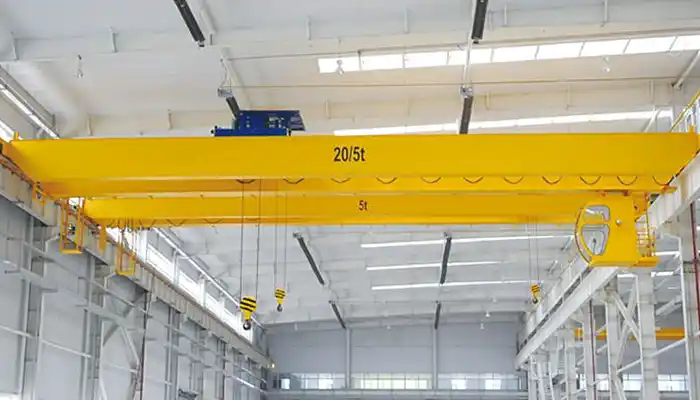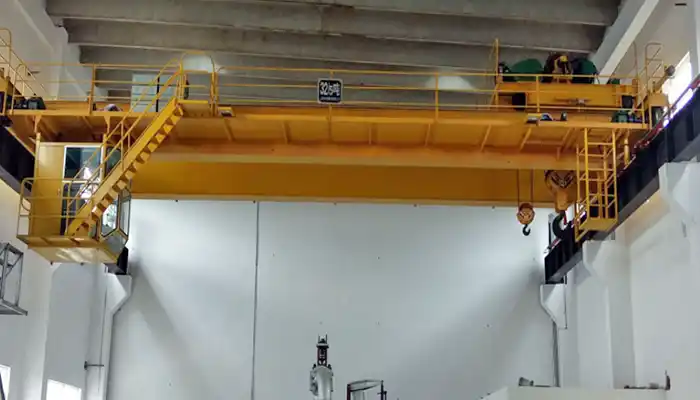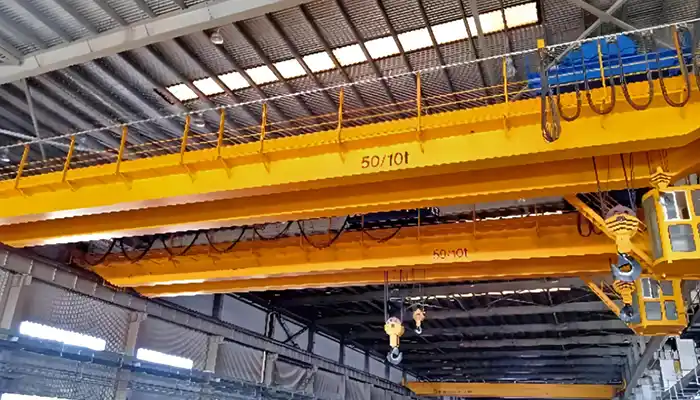Hot Sale Capacities of QD Type Double Girder Cranes
QD Type Double Girder Overhead Cranes
The QD Type Double Girder Overhead Crane is designed for heavy-duty lifting in various industrial settings. With its robust double girder structure, it offers the stability and strength required for handling large, heavy loads. These cranes are commonly used in environments where high lifting capacities and precision are essential, including manufacturing plants, construction sites, and port operations.
- Double girder design provides enhanced stability and strength.
- Equipped with an open winch system for smooth, efficient operation.
- Ideal for lifting large and heavy materials or equipment.

Importance of Understanding Hot Sale Capacities for Specific Applications
Understanding the lifting capacities of QD double girder cranes is critical when selecting the right crane for a specific application. The crane’s lifting capacity dictates how much weight it can handle safely and efficiently. Choosing the right capacity ensures that the crane can meet the demands of the operation, improve safety, and increase overall productivity by matching the crane's capabilities to the materials being handled.
- Lifting capacity affects crane performance, safety, and operational efficiency.
- Choosing the right capacity prevents overloading and underutilization.
- Ensures safe handling of materials or equipment within operational limits.
Brief Introduction to Popular Lifting Capacities and Their Market Demand
QD double girder cranes are available in various lifting capacities, with some of the most popular being 5 tons, 10 tons, 16/3.2 tons, 20/5 tons, 32/5 tons, 50/10 tons, 75/20 tons, and 100/20 tons. These capacities are in high demand across a range of industries, from light manufacturing to heavy-duty sectors like steel production, construction, and shipbuilding. Understanding the demand for specific capacities helps businesses select the ideal crane for their unique requirements, ensuring maximum efficiency and performance.
- Popular lifting capacities include 5 tons, 10 tons, 50 tons, and 100 tons.
- Higher capacity cranes are preferred in heavy industries like steel production and construction.
- Market trends show demand for mid-range capacities in automotive and light manufacturing.
Hot Sale Capacities of QD Double Girder Cranes
5 Tons Capacity
Common Applications:
The 5-ton crane is perfect for smaller to medium-sized operations that don’t require massive lifting power but still need reliable performance.
- Manufacturing: Ideal for handling smaller machinery, equipment, and parts in production lines.
- Automotive Assembly: A great choice for lifting components like engine parts, chassis, and other smaller assemblies.
- Light Construction: Suitable for lifting building materials such as concrete, steel, and timber in smaller-scale construction projects.
10 Tons Capacity
Frequent Usage:
The 10-ton capacity crane is often used for tasks that demand more lifting power and reach, bridging the gap between light and heavy-duty lifting.
- Warehouses: Perfect for moving heavier goods, pallets, and materials around warehouse spaces.
- Logistics: Commonly used for loading and unloading shipments in ports or distribution centers.
- Material Handling: Great for lifting large containers, construction materials, and factory parts.
16/3.2 Tons Capacity
Dual-Hook Configuration:
With a dual-hook setup, this crane handles multiple load types at once, making it a time-saver and an efficiency booster in many operations.
- Simultaneous Lifting: Perfect for lifting large or irregularly shaped items, like long beams, pipes, and large containers.
- Industries: Frequently used in heavy manufacturing, automotive, and steel industries where simultaneous lifting of different loads is necessary.
20/5 Tons Capacity
Dual-Load Capability:
This crane's dual-load function is perfect for jobs where both light and heavy materials need to be moved at the same time. It’s highly versatile.
- Heavy Equipment Manufacturing: Handles large components like heavy machinery frames, engines, and parts.
- Automotive Sectors: Ideal for transporting engine blocks, chassis, and body panels across automotive assembly lines.

32/5 Tons Capacity
Heavy-Duty Tasks:
Designed for more demanding environments, this crane is built for handling large, heavy loads on a regular basis, providing power and reliability in tough settings.
- Manufacturing Plants: Used to move oversized machinery, parts, and equipment that require significant lifting power.
- Construction: Great for lifting heavy construction materials such as steel beams and concrete blocks.
- Shipbuilding: Perfect for moving large ship components, including hull sections, engines, and propulsion units.
50/10 Tons Capacity
Widely Used in Heavy Industries:
When you need a crane that can take on heavy-duty tasks, the 50/10-ton model is built for just that. It’s commonly found in industries where strength and power are key.
- Steel Mills & Foundries: Lifts heavy steel coils, slabs, and molten metal containers.
- Power Plants: Moves large equipment such as turbines, generators, and electrical components.
- Construction Projects: Handles large construction beams, heavy machinery, and components in large-scale infrastructure projects.

75/20 Tons Capacity
Heavy Construction & Industrial Projects:
The 75/20-ton crane excels in industrial and construction projects where massive materials are moved. Its dual-hook system ensures stability while lifting.
- Construction: Great for lifting structural components like steel beams, girders, and large concrete slabs.
- Industrial Projects: Handles large machinery and construction materials needed for large-scale industrial projects.
100/20 Tons Capacity
High Load Handling:
When you need a crane that can handle extremely heavy and large loads, the 100/20-ton model is a top choice for industries that require top-tier lifting capacity.
- Steel Manufacturing: Lifts and moves large steel rolls, billets, and other heavy materials in steel mills.
- Shipbuilding: Assists in lifting heavy ship components like engines, hull parts, and structural sections.
- Large Machinery Assembly: Perfect for handling massive components used in assembling large industrial machinery, such as turbines, generators, and other heavy-duty equipment.
Factors Influencing Popularity of These Capacities
Industry Needs
Different industries have distinct demands, and crane capacities are often chosen based on specific tasks and operational requirements. The need for higher lifting capacity tends to be more prominent in certain sectors, driven by the materials and tasks at hand.
- Construction: Large-scale projects require cranes with significant lifting capacity. Whether it’s lifting steel beams or concrete panels, a crane with 50/10 tons or even 100/20 tons capacity is essential for these heavy-duty tasks. These cranes provide the strength needed for large, heavy loads and the ability to move materials across expansive sites.
- Automotive: In automotive manufacturing, cranes with lifting capacities of 10 tons or 16/3.2 tons are common. These cranes handle parts like engines, body frames, and chassis with precision, helping streamline production lines. The ability to lift large components efficiently is critical in this fast-paced environment.
- Heavy Machinery Manufacturing: Industries focused on assembling large machinery need high-capacity cranes to move massive components. Cranes with 50/10 tons, 75/20 tons, and 100/20 tons are ideal for lifting heavy parts like turbines, mining equipment, and large vehicle assemblies.
Work Environment
The work environment plays a big role in determining which crane capacity will work best. From tight spaces to vast construction sites, cranes are selected based on available space, load types, and handling precision.
- Space and Precision: When space is limited, smaller cranes with 5 tons or 10 tons capacities are often the go-to option. These cranes are easier to maneuver in confined areas, offering the precision needed to handle smaller, more delicate loads in environments like warehouses or light manufacturing plants.
- Large-Scale Sites: For construction projects with vast open spaces, heavier-duty cranes with capacities of 32/5 tons, 50/10 tons, or even 75/20 tons are more common. These cranes can cover more ground, lifting larger loads across wider areas, which makes them essential for big projects like bridge construction or shipbuilding.
- Tough Environments: Cranes in harsh environments—like steel mills, foundries, or shipyards—need to be robust and capable of withstanding heavy use. Larger cranes with capacities of 50 tons and above are designed for durability, able to handle continuous heavy lifting without compromising on performance.
Customization Options
Cranes that can be customized are always in high demand. Industries often require features that go beyond standard lifting capacity to meet their specific operational needs.
- Specialized Lifting Devices: Many industries require cranes with specialized attachments, such as magnetic chucks, C-hooks, or grab buckets. For example, in steel mills, a 50/10-ton crane can be equipped with a magnetic chuck to lift steel plates and coils. This makes the crane more versatile and efficient for specific tasks.
- Dual-Hook Configurations: Cranes like the 16/3.2-ton and 20/5-ton models come with dual-hook configurations, which allow operators to lift multiple loads simultaneously. This feature is incredibly useful in environments like automotive assembly lines or large warehouses, where efficiency is key to keeping things moving.
- Safety Features: In high-risk industries, safety is always a priority. Custom cranes come equipped with advanced safety features like overload protection, anti-collision systems, and remote emergency stop functions. These features are essential in environments such as heavy machinery manufacturing, where safety standards are critical.
Applications for Each Hot Sale Capacity
5-10 Tons: Ideal for Lighter Loads
Cranes in the 5-10 ton range are commonly used for lighter lifting tasks. They’re perfect for environments that deal with smaller to medium-sized components and materials. Their versatility makes them popular in a wide range of industries.
- Machinery Parts Handling: These cranes are frequently used in factories where machinery components need to be lifted and moved with care. Their precision allows for the handling of parts like gears, pulleys, and small engine blocks.
- Equipment Assembly: In automotive plants or small manufacturing units, cranes with 5 to 10 tons capacity are used to assist in assembling machinery and heavy equipment. They can easily lift chassis, small engines, and other vehicle components.
- Materials Handling: In warehouses and distribution centers, these cranes are invaluable for moving pallets, raw materials, and smaller loads that require frequent, quick lifts. Their moderate capacity is well-suited for environments with limited space or smaller-scale tasks.
16/3.2-32/5 Tons: Ideal for Medium-Duty Tasks
The 16/3.2 tons and 32/5 tons cranes are designed for handling heavier loads and are commonly used in industries where materials are bulkier and more challenging to lift. These capacities are ideal for mid-range lifting operations.
- Steel Plates and Heavy Equipment Assembly: These cranes are essential in steel mills and heavy equipment manufacturing, where steel plates, beams, and machinery need to be transported. Their dual-hook configurations allow for lifting multiple pieces simultaneously, improving efficiency in such settings.
- Large Components Handling: These cranes are also widely used in the automotive industry for moving larger components like engines, transmissions, and frames. Their precise control and capacity make them ideal for tasks where accuracy is just as important as lifting power.
- Construction and Industrial Manufacturing: In sectors like construction or industrial manufacturing, cranes in the 16/3.2 tons and 32/5 tons range are ideal for lifting heavy construction materials like concrete panels, steel beams, and oversized parts. Their load handling capability makes them indispensable for projects requiring both strength and accuracy.
50/10-100/20 Tons: Best for Heavy-Duty Industrial Work
When it comes to heavy-duty lifting, the 50/10 tons to 100/20 tons range of cranes is in a league of its own. These high-capacity cranes are built to handle large, heavy loads in demanding industrial environments, from steel mills to large construction sites.
- Steel Production: In steel mills and foundries, these cranes are essential for lifting heavy steel coils, slag pots, and large furnace parts. Their ability to handle high heat, heavy weights, and continuous operation makes them ideal for this high-demand industry.
- Shipbuilding and Ship Repair: In shipyards, 50/10 tons to 100/20 tons cranes play a critical role in moving large ship components, such as engines, propellers, and hull sections. These cranes are built to lift heavy loads with precision, crucial in such a delicate environment.
- Large Infrastructure Projects: For large construction projects like bridge building, tunnel construction, and power plants, these cranes are used to move massive construction materials, including steel beams, concrete slabs, and prefabricated components. Their power and reach make them indispensable for these large-scale undertakings.
Benefits of Choosing the Right Hot Sale Capacity
Enhanced Efficiency
Selecting the right crane capacity for your specific needs directly impacts operational efficiency. When you match the crane's lifting ability to the task at hand, you minimize downtime and speed up workflows.
- Faster Operations: The right-sized crane moves materials faster, reducing delays in production or assembly lines. This is especially true for industries with tight schedules, like automotive manufacturing or heavy equipment assembly.
- Improved Workflow: With the right lifting power, operators can handle materials more quickly and safely, ensuring smooth and continuous operations without bottlenecks or delays.
Cost-Effectiveness
Opting for the appropriate crane capacity can also lead to significant cost savings in the long term.
- Reduced Overcapacity: A crane that’s too large for the task at hand might be more expensive to purchase and maintain. On the other hand, using a crane that’s too small can lead to inefficiencies and possible wear-and-tear. Matching the crane to the load ensures you're getting the most value for your money without unnecessary expenses.
- Lower Operating Costs: Properly sized cranes are more energy-efficient and require less maintenance over time, lowering operational costs. They are designed to handle loads without strain, leading to fewer breakdowns and repairs.
Safety and Precision
Choosing the right crane size is essential for maintaining safety in high-stakes environments.
- Avoid Overloading: Selecting a crane with the right capacity reduces the risk of overloading, which can lead to dangerous accidents. This is particularly important in industries like steel manufacturing or shipbuilding, where the weight and size of materials are crucial for safe handling.
- Precision Lifting: With the correct crane size, operators can lift materials with greater precision. This is especially important in tasks like lifting large components in automotive manufacturing or handling steel plates in construction. Proper size ensures the materials are moved safely and accurately, preventing accidents or damage.
Conclusion
In this overview, we've explored the most popular QD double girder crane capacities, each serving a distinct set of industrial needs. From lighter loads handled by 5-ton and 10-ton cranes to the heavy-duty capabilities of 100-ton cranes, these cranes provide essential lifting power across a variety of sectors.
- Popular Capacities Recap: The 5-10 ton range is ideal for light material handling, such as parts assembly and equipment moving. The 16/3.2-32/5 ton range serves medium-duty tasks like heavy equipment assembly and steel plate movement. For the most demanding industrial tasks, the 50/10 to 100/20 ton range is perfect for large-scale projects in steel production, shipbuilding, and infrastructure.
- Final Recommendation: When selecting the right crane capacity, it's important to align the crane’s lifting capabilities with the specific requirements of your application. Consider the materials you handle, the space available for operation, and the weight demands of your tasks. Matching the right crane capacity ensures optimal efficiency, cost-effectiveness, and safety in the long run.
By understanding these popular crane capacities and their industrial uses, businesses can make informed decisions that meet their unique needs and improve overall operational performance.




